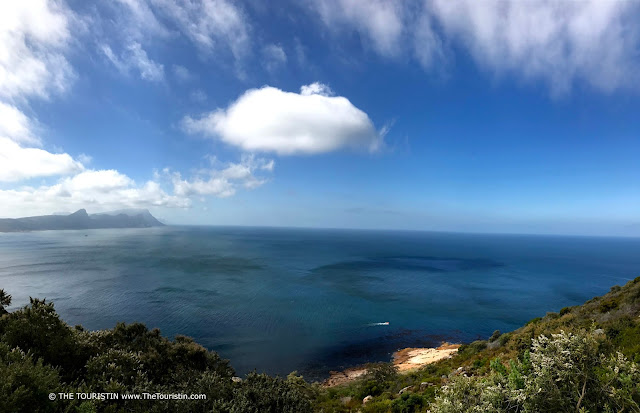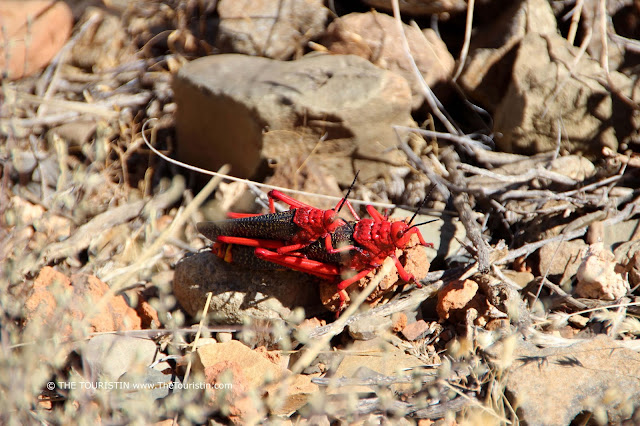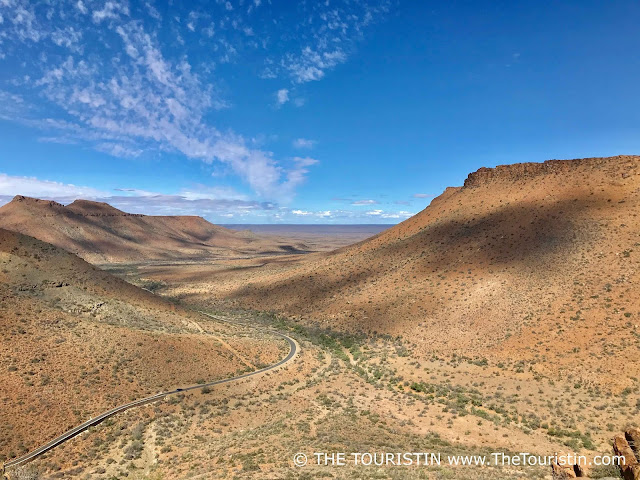You must have experienced this too, you ask people how they are and the repeat answer by literally everybody is ”I’m so very busy.” Do people need to go out more to recharge? I highly recommend spending time in a National Park. One of the biggest benefits clearly is to breathe fresh air; it is something that we often don’t have living in air polluted towns or big cities. No matter where you go to find nature, even the tiniest thing is interesting, just looking at a beetle or listening to bird song will bring relaxation. Visiting National Parks in South Africa is an excellent way to experience the diversity this country has to offer.
Most
people probably visit National Parks to spot the big five (lion, elephant,
buffalo, rhinoceros, leopard) and that really is the perfect plan. Remember
that there is so much more to see and smell. Please do not mistake National
Parks for zoos. You sometimes will have to drive or wait at waterholes for a
good few hours till you spot an animal. It is nature, there are no set rules
and no feeding times for wildlife, wildlife is wildlife, animals don't roam these
parks for our entertainment, they live in these areas since they have to be
protected from the biggest predator there is: us humans. Leave camp early, turn
off the air conditioning, roll down your windows, feel the wind, feel the
rising heat of the day, that way you might better understand animal's
behaviour. Have a tea break when it gets too hot. Keep as quiet as you can, and
please turn off the engine while you look at wildlife, others might enjoy the
sound of silence more than the sound of your engine. Silence is key, it makes
the experience extra special. We have to listen to so much noise in our daily
lives. Look and listen, embrace the moment.
The
good thing is that you can visit all of these National Parks by yourself and
travel at your own pace. I drove to and through all the parks I recommend here
in my Land Rover Defender. Read: How to easily prepare for a self-drive
safari in Southern Africa. On arrival in parks I get enough information by
staff at reception and I ask rangers on site if I have questions about animals
and plants. In some parks you can contact the rangers at camps and ask for
guided night drives and bush walks (best to inquire on arrival). As far as my
experience goes accommodations and campsites are exceptionally well looked
after, considering the remoteness of most places and the distance one has to
travel to reach the next town.
With every visit and with every entrance fee paid to SAN Parks, you help to conserve wildlife and secure South Africa’s biodiversity. Travel and do good, a perfect combination. What follows is a short overview to inspire your next trip to South Africa or your next trip in South Africa. I know it is not exactly short, I tried to keep it short but there is so much to see in this country.
Addo Elephant Park in the Eastern Cape
South Africa's third largest National Park, that is easy to reach in your own car in under one hour from Port Elizabeth, offers a wide range of biodiversity. This is the place where you can see what feels like a gazillion elephants in one day, roughly 400 elephants call Addo home. Study them for a few days and see how the elephants interact and live together. It can get busy at waterholes.
Info Addo Elephant Park. R335 Paterson Road. Addo 6105 South Africa. Conservation fee/day locals: ZAR 62 (EUR 4.53) / foreign visitors: ZAR 248 (EUR 18.13). Wide range of accommodation, e.g. safari tents with fridge and barbeque facilities per night ZAR 815 (EUR 59), additional child free. For more info contact: addoenquiries@sanparks.org
Agulhas National Park in the Western Cape
This is the southernmost tip of the African continent, and where the Atlantic and the Indian Ocean meet, and that every moment of the day, each day of the year. If you like driving you could even go for a day trip from Cape Town, but it is so much nicer to stay for a few nights to really appreciate the peacefulness, the vastness and the sound of the crashing waves together with the smell of the ocean and kelp. At night it is especially magical when there is nothing near and far but a starry night sky. If you stand on land, concentrate, look straight ahead, you can see Antarctica (as if, but it would be amazing and in theory it is possible). The wreck of the Meisho Maru 38, a Japanese trailer that run aground in spring 1982 is a great photo op. Take the opportunity while you can, it might be gone one day. You can even go whale watching from June to September.
Info Agulhas National Park. 214 Main Road, Agulhas, Bredasdorp 7287 South Africa. Conservation fee/day locals: ZAR 37 (EUR 2.70) / foreign visitors: ZAR 148 (EUR 10.80). Accomodation includes camping facilities and chalets, eg chalet with fridge and barbeque facilities per night ZAR 1100 (EUR 80), additional child ZAR 120 (EUR 8.40). For more info contact: agulhasinfo@sanparks.org.
 |
| Cottage Agulhas Restcamp at Cape Agulhas National Park |
 |
| Lighthouse on a sunny day Cape Agulhas National Park |
 |
| Sunset Cape Agulhas National Park |
Augrabie Falls National Park in the Northern Cape
This park west of Upington is the place of the so called great noise. Thanks to the Orange River there is a massive waterfall during the wet season, and that in the middle of a desert. There are different hiking trails along the canyon and a wooden walkway along lookout points. The rock formations and scenery is overwhelmingly beautiful but the biggest little stars of this park are the dassies. Please talk to your doctor about malaria prophylactics and wear closed shoes at night to avoid scorpion stings.I know I said malaria-free, I didn't take any prophylactics at the time of my visit and wasn't aware of it (but San Parks mentions this now on their website).
Info Augrabie Falls National Park. Augrabies 8874 South Africa. Conservation fee/day locals: ZAR 44 (EUR 3.20) / foreign visitors: ZAR 176 (EUR 12.82). Accomodation includes camping facilities and chalets, eg chalet with fridge and barbeque facilities per night ZAR 1090 (EUR 79.40), additional child free. For more info contact: augrabiesres@sanparks.org.
Bontebok National Park in the Western Cape
As the name of South Africa’s smallest national park gives away this park is all about the preservation of Bonteboks. You will also easily spot Cape mountain zebras and red hartebeest. Go for hikes or a circular drive by car, set up camp, go for a swim in the Breede river, light a fire and watch most amazing sunsets. The Langeberg Mountains in the distance are the perfect background for this little adventure. The park is only a moments drive from the town of Swellendam.
Info Bontebok National Park. Swellendam 6740 South Africa. Conservation fee/day locals: ZAR 37 (EUR 3.20) / foreign visitors: ZAR 100 (EUR 12.82). Accomodation includes camping facilities and chalets, eg chalet with fridge and barbeque facilities per night ZAR 1060 (EUR 77.30), additional child ZAR 120 (EUR 8.75). For more info contact: bontebok@sanparks.org.
 |
| Sunset Breede River Bontebok National Park |
 |
| Zebra Bontebok National Park |
Karoo National Park in the Western Cape
This park is in the Great Karoo with
the entrance gate near Beaufort West. The views over the wide-open land are as
endless as the air is fresh. Enjoy the tranquillity and if you are lucky you
will even see lions. On both my visits, I sadly didn't see a lion, maybe next
time. Apparently ten lions call this region home. A woman tells me she saw two. I see Red hartebeest, Greater Kudu, Cape Mountain Zebras (on the slopes of a mountain), and a young antelope I can’t identify. It is all about spending time in nature and enjoying the solitude and not so much about how many lions one sees. Most of the roads are suitable for sedans.
Info Karoo National Park: N1 Beaufort West, South Africa. Conservation fee/day locals: ZAR 44 (EUR 3.19) / foreign visitors: ZAR 176 (EUR 12.77). Accommodations range from camping facilities that start at ZAR 275 (EUR 19.95) to chalets and cottages ZAR 1285 to ZAR 1910 (EUR 93.20 to EUR 138.51) for four adults, additional child ZAR 170 (EUR 12.33). For more info contact: karooreservations@sanparks.org.
Kgalagadi Transfrontier Park in the Northern Cape
Red dunes, sociable weavers and lions ... This is a place of true African wilderness (the other National Parks are somehow wild too of course). Please read 8 magnificent things to do in the Kgalagadi Transfrontier Park, an article I wrote recently. Note: It is essential that you bring your own drinking water, firewood, food etc.
Info Kgalagadi Transfrontier Park: Twee Rivieren, South Africa. Conservation fee/day locals: ZAR 76 (EUR 5.56) / foreign visitors: ZAR 304 (EUR 22.20). Accommodations range from unpowered camping facilities over chalets, to unfenced secluded chalets with fridge and barbeque facilities per night. Camping starts at ZAR 285 (EUR 20.83. For more info contact: kgalagadi@sanparks.org.
 |
| Meerkats on guard, Kgalagadi Transfrontier Park |
 |
| A lioness, Kgalagadi Transfrontier Park |
Namaqua National Park in the Northern Cape
This park not too far from the Namibian border is the home of the world’s smallest tortoise, the Namaqua speckled padloper and conserves the world’s richest flora. It is the obvious place to stay in spring when the area is in full bloom but I love to visit outside of flower season to have the whole area to myself, it feels so very remote and lonely, visiting this park and camping right by the ocean is an adventure not to be missed. Read Vast and unspoilt coastline –trip to Namaqualand.
Info Namaqua National Park: Kamieskroon, South Africa. Conservation fee/day locals: ZAR 37 (EUR 2.68) / foreign visitors: ZAR 74 (EUR 5.37). Accommodations range from unpowered camping facilities by the beach to chalets with barbeque facilities per night. Camping starts at ZAR 135 (EUR 9.81. For more info contact: elanza.vanlente@sanparks.org.
 |
| Camping in Namaqua National Park |
 |
| Kelp on the beach Namaqua National Park |
 |
| Paw prints in the sand Namaqua National Park |
 |
| Beach Namaqua National Park |
Table Mountain National Park on the Cape Pensinsula
Cape Town is the home of the one and only iconic and beloved Table Mountain, one of the seven natural wonders of the world and a national heritage site. There are several ways and routes to get to the top, take the cable car or hike one of the many trails. You might also want to go for hikes on nearby Signal Hill and Lions Head. Please let someone know where you plan to walk before you head off, it is best if you won’t hike alone, why not try to form a small group, it is more fun and safer.
Remote beaches like Noordhoek below Chapman’s Peak Drive, Misty Cliffs, or Dias Beach at Cape Point are all breathtakingly beautiful. Boulders is a rather lively beach and together with its picturesque swimming beaches between huge boulders its biggest draw card is the colony of adorable and unfortunately endangered African Penguins.
You could easily spend a month of vacation exploring Cape of Good Hope, Newlands, Oudekraal, Perdekloof, Silvermine and Tokai, and I promise that at the end you wouldn’t have seen everything there is to discover. Top tip: Please do not feed baboons, they are wild animals.
Info Table Mountain National Park. There are several options for overnight stays in the different parks, you can chose from a wide range of camping facilities or overnight stays at cottages, from ZAR 650 to ZAR 4.300. For more info contact: tablem@sanparks.org.
Cape of Good Hope Conservation fee/day locals: ZAR 70 (EUR 5.10) / foreign visitors: ZAR 70 (EUR 5.10). Newlands Conservation fee/day locals: ZAR 25 (EUR 1.82) / foreign visitors: ZAR 25 (EUR 2.92). Oudekraal Conservation fee/day locals: ZAR 40 (EUR 1.82) / foreign visitors: ZAR 40 (EUR 2.92). Perdekloof Conservation fee/day locals: ZAR 15 (EUR 1.10) / foreign visitors: ZAR 15 (EUR 1.10). Silvermine Conservation fee/day locals: ZAR 50 (EUR 3.65) / foreign visitors: ZAR 50 (EUR 3.65). Tokai Conservation fee/day locals: ZAR 25 (EUR 1.82) / foreign visitors: ZAR 25 (EUR 1.82).
 |
| Cape of Good Hope National Park |
 |
| Cape of Good Hope National Park |
 |
| Simon's Town Beach |
 |
| Endangered (IUCN) African penguin Simon's Town |
 |
| Boulders Beach Simon's Town |
 |
| Endangered (IUCN) African penguins Simon's Town |
Tankwa Karoo National Park in the Northern Cape (almost Western Cape)
Zero air and light pollution, wide open spaces and harsh conditions, that is the Karoo. This park is the ultimate road less travelled destination. From all other parks I visited this is the one where I damaged most tires, on one of my trips I even helped other tourists to change a tire. As I learned, carrying one or two spare tires is a clever thing to do. You have to be fully self sufficient, there are no shops, bring your own supplies (food, wood, firelighters). This is a place of natural wonder, wait till you see the night sky. It feels like you are in the middle of nowhere, at the end of the world, when in reality the park is only two to three hours drive from Cape Town. You can spend days here without seeing another human soul. Please read Tankwa Karoo National Park South Africa - ultimate road less travelled destination. Tipp: Do not feed the baboons, they are wild animals.
Info Tankwa Karoo National Park: R355 Calvinia, South Africa. Conservation fee/day locals: ZAR 37 (EUR 2.69) / foreign visitors: ZAR 136 (EUR 9.90). Accommodations range from camping facilities, starts at ZAR 120 (EUR 8.72) to secluded chalets ZAR 1185. For more info contact: tankwa@sanparks.org.
 |
| Sunset Tankwa Karoo National Park |
 |
| Milkweed locusts Tankwa Karoo National Park |
|
 |
| Hiking in Tankwa Karoo National Park - Baboon prints on the trail |
 |
| Abandoned farm houses Tankwa Karoo National Park |
 |
| Scrub hare - Tankwa Karoo National Park |
 |
| Road Tankwa Karoo National Park |
West Coast National Park in the Western Cape
What is the saying? The West Coast is the best coast? I can only agree. White endless and wild beaches, the smell of the ocean and kelp under a wide open sky, at most times dotted with only a few fluffy clouds. Then there is a Langebaan lagoon, and the only thing I can think of is its soft sand, azure water and pink flamingos. There are several hiking trails through dunes and strandveld, and the walks along the beach are a dream too. Try to make time to pop into the restaurant Geelbek, the Roasted Butternut Salad gives you all the energy you need for another beach walk or an afternoon spend in the nearby bird hide.
Info West Coast National Park: West Coast DC, South Africa. Conservation fee/day locals: ZAR 50 (EUR 3.63) / foreign visitors: ZAR 75 (EUR 5.45). Accommodation: Rent a cottage, rates between ZAR 1.500 and ZAR 2.000 for four adults plus additional costs for children (EUR 108 to EUR 145). For more info contact: moipone.thathane@sanparks.org. for opening hours of the restaurant, email geelbekrestaurant@telkomsa.net.
 |
| Beach walk West Coast National Park |
 |
| Dunes West Coast National Park |
 |
| Geelbek Restaurant West Coast National Park |
 |
| Octopus West Coast National Park |
 |
| Lagoon West Coast National Park |
Have lots of fun in South Africa, one of the most diverse and beautiful places on earth. When I wrote this, with every park I thought this one is the best, but then I wrote about the next one and the next one. It is impossible for me to say which one is the best, I love them all equally and I will forever hope to return as often as I can. Please check current prices and conditions with SAN Parks before you go on that trip.
From Berlin with love



































